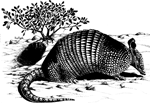Vertebrate Pest Conference: Proceedings

Vertebrate Pest Conference Proceedings: 9th (1980)
Date of this Version
March 1980
Document Type
Article
Abstract
The black rat (Rattus rattus) causes severe damage to coconut (Cocos nucifera) crops in Colombia. These rodents climb to the crown of producing palms and often nest there. Damage results from the rats gnawing the shells of the coconuts until they penetrate to the endosperm; the perforated nuts will fall within a period of 15 days and are unsuitable for harvest. Since 1972, the Colombian Agricultural Research Institute (Instituto Colombiano Agropecuario or ICA), through its Vertebrate Control Program, has been conducting a series of investigations to obtain information about the characteristics of this damage and the best means of reducing it. Damage surveys in several of the principal coconut-producing areas reveal a high percentage of crop loss (e.g., Tumaco 20%, San Andres Island - 34%, and Gorgona Island - 60%) and illustrate the seriousness of the problem. The lack of water (i.e., rainfall) during the dry season seems to be associated with increased damage. In some areas, such as San Andres, the planting density is excessively high. Hence, physical barriers such as metal bands on the trunk are ineffective -- the proximity of the palms allows the rats to transit easily among adjacent trees on overlapping fronds. Our observations indicate that chemical control using anticoagulant baits placed in the palm crowns, significantly reduces damage. The effect of a single baiting can last up to six months, with the length of the effect dependent upon cultural practices implemented after treatment (e.g., maintaining cleanliness of area, weed control, etc.). At present, chemical control and associated cultural practices is the program recommended by ICA for reduction of rat damage to coconut crops in Colombia.

